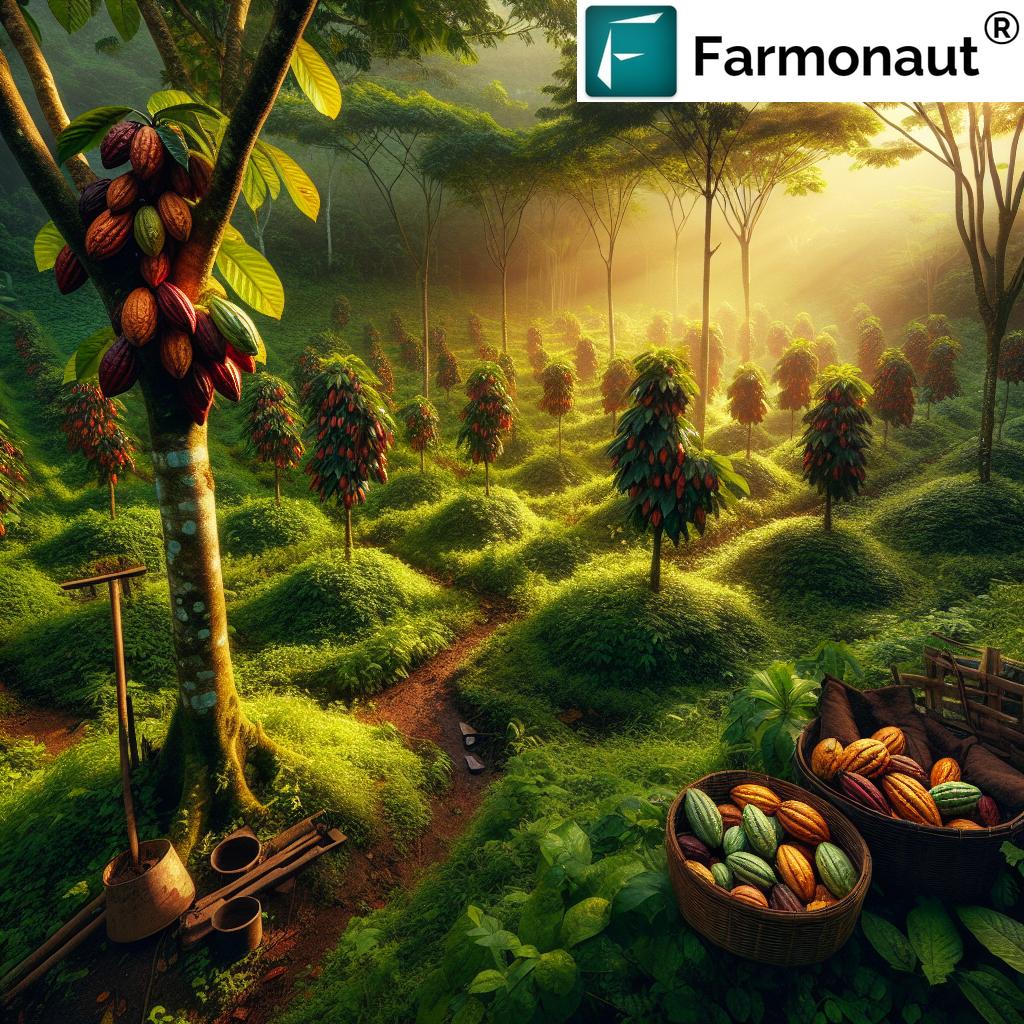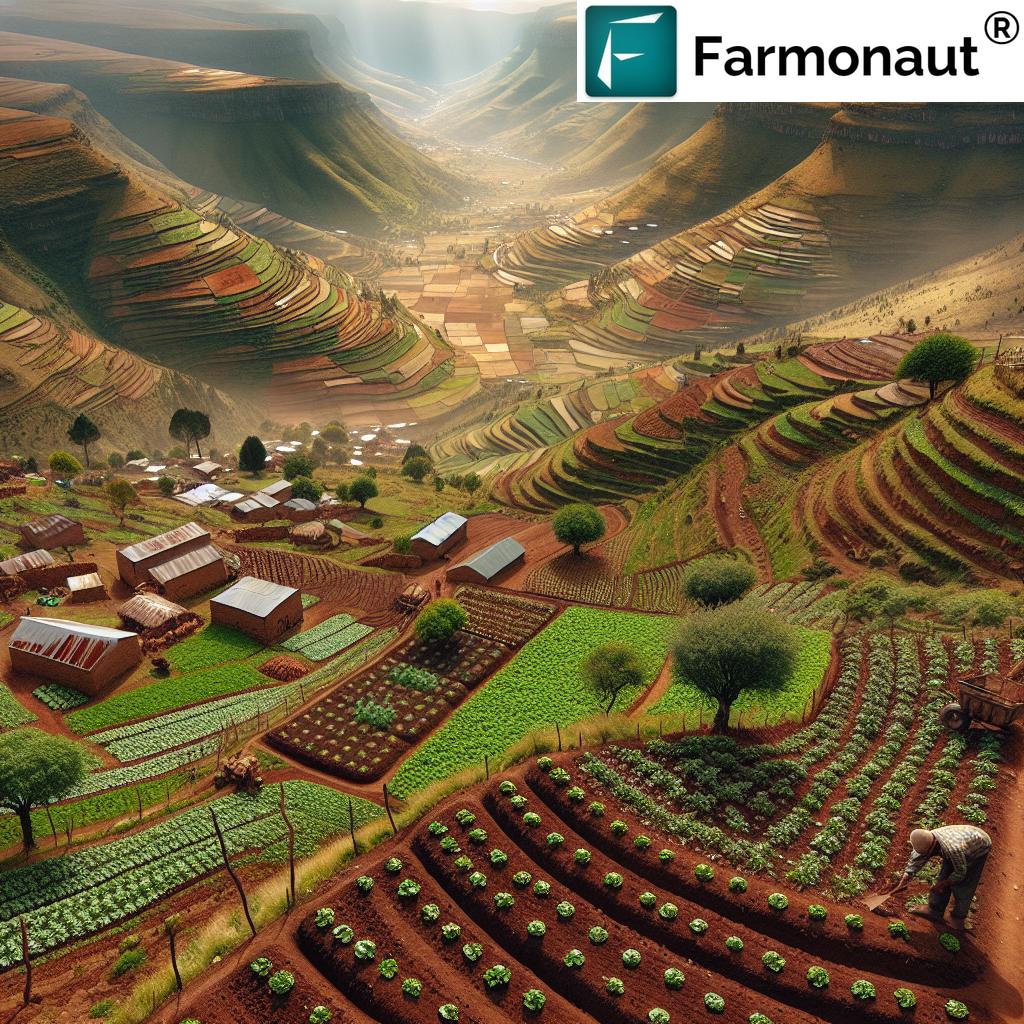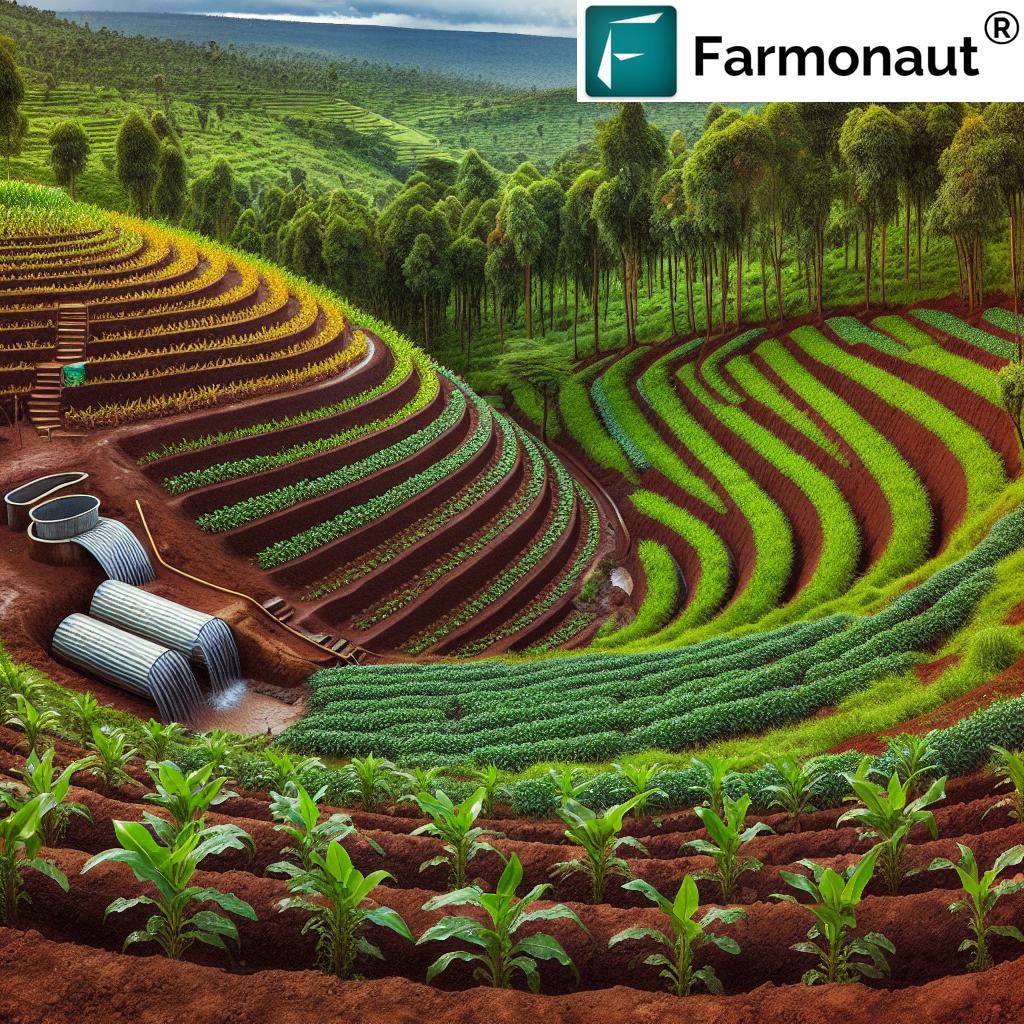Cocoa in Ghana: 7 Powerful Solutions for Sustainable Growth
“In Ghana, cocoa farming supports over 800,000 households, making it the backbone of the rural economy.”
Table of Contents
- Historical Context and Economic Significance of Cocoa Production in Ghana
- Geographical Distribution and Cocoa Production Regions
- Cocoa Farming Practices in Ghana
- Ghana Cocoa Industry Challenges
- Government Initiatives for Cocoa Sector Sustainability
- Sustainable Solutions and Growth Opportunities
- Empowering Cocoa Sustainability: How Farmonaut’s Technology Supports Ghana’s Cocoa Sector
- Challenges vs. Sustainable Solutions Table
- Conclusion & Next Steps
- Frequently Asked Questions
1. Historical Context and Economic Significance of Cocoa Production in Ghana
Since its introduction in the late 19th century, cocoa has shaped Ghana’s agricultural landscape, becoming the backbone of our rural economy. By the mid-20th century, Ghana had already established itself as a global leader, consistently ranked as the world’s second-largest cocoa producer.
The economic significance of cocoa cannot be overstated. The sector generates an estimated $2 billion in annual foreign exchange revenue (source), supporting approximately 800,000 farming households across the Ashanti, Western, and Eastern regions. This immense contribution underpins Ghana’s global reputation in commodity export markets, while providing direct support for rural livelihoods, social development, and infrastructure investments.
Cocoa production in Ghana is not just a matter of export revenue, but also a matter of national pride, sustainable economic growth, and resilience. As we explore the roots and far-reaching impacts of cocoa farming, we see clearly how deeply intertwined our rural and national prosperity is with this unique crop.
2. Geographical Distribution and Cocoa Production Regions
Cocoa thrives in the moist, rainforest belt of southern Ghana, thanks to favorable climate and rich soils. Our nation’s cocoa farming is clustered predominantly in three primary regions: Ashanti, Western, and Eastern.
- Ashanti Region – The powerhouse of Ghana’s cocoa industry, producing around 290,000 metric tonnes annually. The prevalence of forested areas, suitable precipitation, and traditional farming expertise drive productivity here.
- Western Region – A close second, contributing 275,000 metric tonnes annually. The Western enclave is notable for its vast land availability, ongoing plantations expansion, and significant potential for sustainable initiatives.
- Eastern Region – Supplies approximately 200,000 metric tonnes yearly, playing a vital supporting role. The Eastern region’s smallholder farms are the lifeblood of local production chains.
Together, these three regions account for over 60% of the country’s cocoa output (source). Despite this concentration, cocoa farming is truly a nationwide effort, with farms extending into Brong Ahafo, Central, Volta, and other forest regions. Our geographical landscape thus offers powerful opportunities for regionally tailored, sustainable growth strategies.
“Deforestation linked to cocoa cultivation in Ghana reached 315,000 hectares between 2001 and 2014.”
3. Cocoa Farming Practices in Ghana
Our approach to cocoa farming practices is predominantly smallholder-based, with most farmers managing plots of fewer than three hectares. These small-scale, family-run farms follow a time-honored process:
- Harvesting: Ripe cocoa pods are hand-harvested from trees using specialized knives or rods, cutting pods at their stalks for minimal harm.
- Pod Breaking: Pods are carefully opened on the farm, and the beans are separated from the pulp.
- Fermentation: Essential for flavor development, fermentation takes place over six days in wooden boxes or heaps, with three turnings to ensure even microbial activity.
- Drying: The beans are then sun-dried for roughly a week, periodically stirred to promote consistency and prevent mold growth.
- Bagging, Grading, and Sealing: Once dried, beans are bagged, graded by quality, and sealed, ready for local processing or export markets.
This meticulous process shapes the reputation of Ghana’s cocoa as a premium commodity worldwide (source). However, traditional methods face mounting pressures—aging trees, low productivity, and evolving environmental threats—which we examine in depth below.
4. Ghana Cocoa Industry Challenges
Let’s delve into the critical challenges that currently threaten the sustainability and growth potential of cocoa production in Ghana. Recognizing these obstacles is the first step in crafting actionable, sustainable solutions.
A. Aging Farms, Trees, and Declining Productivity
Many cocoa farms are aging, with a workforce and cocoa trees often exceeding their productive prime. Yields decline markedly after 20 years, yet rejuvenation costs and the demanding, labor-intensive nature of cocoa cultivation deter younger generations from taking up the profession (source).
- Average smallholder farm size: less than 3 hectares
- Tree productivity declines sharply after age 20
- Inadequate generational succession threatens long-term sector stability
B. Pests and Diseases
The threat of pests and diseases endangers entire harvest cycles. Black pod disease, notably caused by Phytophthora megakarya, devastates yields, while cocoa swollen shoot virus and mirids further erode productivity.
- Black pod disease alone can reduce local yields by 20-30% without vigilant control (source).
- Traditional management practices are often insufficient, requiring integrated pest management strategies with research-driven resistant varieties.
C. Impact of Climate Change on Cocoa
Our cocoa sector is highly sensitive to the impact of climate change on cocoa: erratic rainfall, droughts, and higher temperatures threaten both yields and farm incomes. This growing risk underscores the urgent need for climate adaptation and resilient farming practices (source).
- Increased rainfall variability impacts flowering and fruiting cycles
- Drought and heat stress reduce bean quality and survival rates of young trees
D. Deforestation and Cocoa Farming
The deforestation and cocoa farming debate is at the forefront of industry discourse. Expansion onto new lands—often forested—drives significant habitat loss and carbon emissions.
- Ghana lost 79% of forest cover (1960–2015) due in part to cocoa expansion (source)
- Between 2001–2014: over 315,000 hectares deforested for cocoa
- Global pressure is mounting for zero-deforestation sourcing and more sustainable production practices
E. Cocoa Smuggling in West Africa
Cocoa smuggling in West Africa, particularly across Ghana’s borders, undermines farmer income stability, state revenues, and the integrity of market prices.
- In 2023, Ghana lost 160,000 tonnes (over a third of national output) to smuggling, mainly due to price differentials with neighboring countries (source)
- The illegal trade ultimately weakens financial resources available for sector reinvestment and farmer support
F. Illegal Mining Activities (“Galamsey”)
The illegal mining phenomenon, known locally as galamsey, leads to land degradation, pollutes water sources, and encroaches on cocoa plantations, resulting in a dual threat of lost farmland and environmental devastation.
- Key cocoa regions are often hotspots for both mining and agriculture, increasing competition for fertile land
- Soil and water contamination further reduce agricultural productivity and raise health risks
5. Government Initiatives for Cocoa Sector Sustainability
Strong government initiatives are central to addressing Ghana cocoa industry challenges and fostering sustainability for rural livelihoods and the wider economy.
A. Land Reclamation and New Plantations
- As of May 2025, the government plans to acquire 200,000 hectares of land for dedicated cocoa plantations (source).
- This initiative aims to revitalize the industry, introduce higher-yielding and climate-tolerant varieties, and counter declining production trends.
B. The Cocoa & Forests Initiative
- Launched in 2017, this major agreement aligns Ghana, Côte d’Ivoire, and leading cocoa buyers with a commitment to end deforestation and restore lost forests.
- The initiative emphasizes climate-smart practices, forest conservation, and corporate accountability (source).
C. Enhanced Smuggling Controls
- The National Anti-Cocoa Smuggling Task Force bolsters border monitoring, using severe penalties (5–10 years in prison) to deter illegal export activities (source).
- Surveillance, community engagement, and price stabilization mechanisms are part of the anti-smuggling toolkit.
D. Policy Focus: Research, Training, and Financing
- Investment in research and development of disease-resistant, climate-adaptive cocoa varieties and training programs for farmers
- Expansion of financial services to fund farm rejuvenation and processing upgrades
6. Sustainable Solutions and Growth Opportunities for Cocoa Farmers and the Economy
Despite these formidable obstacles, we believe the future holds significant opportunities for our sector’s resilience and growth through innovation and sustainable transformation.
A. Expanding Domestic Cocoa Processing in Ghana
A major priority and growth lever lies in cocoa processing in Ghana. Currently, less than 30–40% of beans are processed domestically, with most exported in raw form (source). Expanding value-add processing will:
- Boost local economy by generating jobs and higher tax revenue
- Reduce vulnerability to volatile global prices
- Enable artisanal and industrial chocolate production, as well as other cocoa derivatives, within Ghana
Powerful digital traceability, like Farmonaut’s blockchain-based traceability (read more), further ensures transparency for buyers, regulators, and consumers.
B. Research and Introduction of New Cocoa Varieties
Steady investment in research is crucial for the sustainable evolution of our sector:
- Developing drought- and disease-resistant varieties with higher bean yields
- Enhancing post-harvest storage and transport to curb losses and maximize farm incomes
- Partnering with digital advisory tools, such as Farmonaut’s Jeevn AI Advisory System, to give farmers real-time, data-driven cultivation guidance, ensuring better adaptation to shifting climate and market conditions
See more on Farmonaut’s crop plantation, forest, and farm advisory solutions.
C. Adopting Sustainable Farming Practices in Ghana
- Agroforestry: Intercropping cocoa trees with shade and fruit trees helps restore soil fertility, sequester carbon, and create wildlife corridors. Carbon tracking tools like those offered by Farmonaut (learn more) enable farmers and agribusinesses to monitor and reduce their environmental impact.
- Soil and Water Management: Precision irrigation and nutrient management, guided by real-time satellite monitoring from Farmonaut’s platform, can improve resource efficiency and crop productivity.
- Certified Training Programs: Education in sustainable cocoa cultivation Ghana empowers farmers to increase yields, reduce chemical dependence, and maintain healthy farms.
D. Rural Financing and Insurance
Robust financial inclusion, underpinned by transparent, satellite-verified farm assessments, boosts access to credit and crop insurance (discover Farmonaut’s solutions). This drives innovation and resilience among smallholder farmers.
E. Fleet and Resource Management
For cooperatives and agribusinesses overseeing multiple plantations or extensive supply chains, efficient fleet tracking and asset optimization are vital. Farmonaut’s fleet management tools enable real-time vehicle tracking and logistics management, reducing post-harvest delays and costs.
F. Data-Driven Policy Implementation
Using remote sensing, digital mapping, and supply chain analytics, the government can more precisely allocate subsidies, enforce anti-deforestation policies, and assess climate vulnerabilities. Farmonaut’s open API and developer documentation ensure scalable integration of these analytics into institutional monitoring systems.
G. Large-Scale Plantation Administration
For cocoa conglomerates or government-managed projects, Farmonaut’s large-scale farm management solutions offer multi-farm dashboard oversight, trigger-based alerts, and customized productivity mapping—driving efficiency and sustainability at scale.
7. Challenges vs. Sustainable Solutions Table
| Challenge | Estimated Impact | Sustainable Solution | Estimated Improvement |
|---|---|---|---|
| Deforestation and Cocoa Farming | 79% forest area lost since 1960; 315,000 ha deforested (2001–2014) | Agroforestry, replanting, zero-deforestation sourcing initiatives | Potential 25% reduction in forest loss over 5 years |
| Cocoa Smuggling in West Africa | 160,000 tonnes smuggled in 2023 (~33% of crop) | Border taskforce, farmer price stabilization, traceability tech | Smuggling volume could decline by 40% |
| Low Farmer Income | Incomes fluctuate with global prices; many live on $1.50–$3/day | Domestic cocoa processing, fairtrade premium, financial access, digital advisory | Projected 25–50% income increase for participating farmers |
| Aging Farms & Declining Productivity | Yield can drop to 30% of new-plantation level after 20 yrs | Replanting, climate- and disease-resistant varieties, AI-based management | Productivity can recover by 40–70% (over 10 years) |
| Pests & Diseases | Black pod disease causes up to 20–30% yield loss annually | Integrated pest management, research on resistant varieties, remote disease mapping | Yield losses reduced to ≤10% with best practices |
| Climate Change Effects | Reduced yields & increased production risks | Climate-adapted cocoa, irrigation tech, real-time crop health monitoring | Yield resilience improved by 20–30% |
| Illegal Mining & Land Degradation | Loss of productive land; water/soil contamination | Stricter enforcement, community education, land-use planning tech | Up to 15% more land preserved for cultivation |
8. Empowering Cocoa Sustainability: How Farmonaut’s Technology Supports Ghana’s Cocoa Sector
Leveraging advanced technologies, Farmonaut is committed to making precision agriculture accessible and transformative for cocoa stakeholders across Ghana’s regions. Here’s an overview of how our platform supports the long-term sustainability and profitability of cocoa production:
- Satellite-Based Crop Health Monitoring: Multispectral analyses provide insights into vegetation health (NDVI), soil moisture, and growth anomalies, allowing for proactive management and resource allocation. This not only improves yields but also helps minimize input costs and waste.
- AI Advisory Systems: Our Jeevn AI Advisory delivers real-time, personalized guidance on everything from weather to pest risk—helping cocoa farmers respond rapidly to emerging threats or opportunities.
- Blockchain-Based Product Traceability: Complete supply chain transparency ensures ethical sourcing, deters smuggling, and bolsters both local and global buyer confidence. Read more about how our traceability modules safeguard Ghanaian cocoa exports.
- Fleet and Resource Management: Tools designed for agribusinesses and cooperatives help reduce logistics bottlenecks and improve delivery of harvested beans from growing regions to processing hubs. Fleet management tools ensure every vehicle is tracked and resources are allocated efficiently.
- Carbon Footprinting: Our carbon tracking system allows for real-time monitoring and reporting of emissions, helping stakeholders meet local and international environmental regulations.
By utilizing Farmonaut services across Android, iOS, Web, and API, farmers and agribusiness owners can ensure data-driven decision-making and sustainable growth. For full platform access, register or download the Farmonaut App today.
9. Farmonaut Subscription Plans
10. Conclusion & Next Steps
As explored, cocoa production in Ghana is at the crossroads of tradition, innovation, and sustainability. Our industry—anchored in the Ashanti, Western, and Eastern regions—faces critical challenges ranging from aging trees and diseases to deforestation, smuggling, and the growing impacts of a changing climate. Yet, the opportunities for growth are equally compelling.
With decisive government initiatives, robust investment in research and digital infrastructure, and a commitment to sustainable farming by every actor in the value chain, Ghana can champion a new chapter for cocoa—one defined not by crisis, but by innovation, environmental stewardship, farmer prosperity, and national economic resilience.
Adopting data-driven, precision solutions like those from Farmonaut amplifies these gains—delivering real-time crop health monitoring, climate-smart advisory, blockchain traceability, resource management, and more. Our tools are designed to empower every farmer, cooperative, or policymaker to optimize operations with transparency, reduce environmental footprints, and create inclusive prosperity across our rural population.
Together, let’s forge a sustainable future for Ghana’s cocoa—protecting livelihoods, restoring forests, and positioning our nation at the forefront of global, sustainable commodity leadership.
Ready to drive your own cocoa success? Download Farmonaut today or try our web app.
Frequently Asked Questions (FAQ): Cocoa in Ghana and Sustainable Solutions
Q1: What is the economic significance of cocoa farming in Ghana?
Cocoa farming is pivotal to Ghana’s economy, directly employing over 800,000 households and generating approximately $2 billion in annual foreign exchange. The sector supports rural livelihoods, underwrites public infrastructure, and cements Ghana’s status on the global export stage.
Q2: What are the key environmental challenges facing the cocoa sector?
The most pressing environmental threats include deforestation linked to cocoa farming, land and water pollution from illegal mining (“galamsey”), and soil degradation. Addressing these issues is vital for long-term sustainability and climate resilience.
Q3: How is climate change impacting cocoa production in Ghana?
The impact of climate change on cocoa is evident through erratic rainfall, increased droughts, and rising temperatures, all of which reduce bean yields, quality, and the viability of traditional cocoa-growing regions.
Q4: What is being done to curb cocoa smuggling in West Africa?
The Ghanaian government has intensified border enforcement via the National Anti-Cocoa Smuggling Task Force and is leveraging digital traceability tools. These policies aim to stabilize domestic cocoa prices, retain export volumes, and secure income for cocoa farmers’ livelihoods in Ghana.
Q5: How can farmers improve productivity and sustainability?
Sustainable farming practices such as agroforestry, precision irrigation, disease-resistant planting material, and data-driven farm management (with tools like Farmonaut) can enhance productivity, conserve forests, and yield long-term profitability.
Q6: What digital tools are available for cocoa farmers, cooperatives, and agribusinesses?
Platforms like Farmonaut offer satellite crop monitoring, AI-powered advisory, blockchain traceability, resource/fleet management, and carbon footprint tracking, all aimed at boosting productivity, transparency, and sustainability.
Q7: Is Farmonaut a producer, regulatory body, or an online marketplace?
No. Farmonaut is an agricultural technology solutions provider focused on digital farm management, precision satellite monitoring, carbon tracking, traceability, and advisory—but it does not buy or sell cocoa, manufacture farm inputs, or act as a sector regulator.
Q8: How can I get started with Farmonaut platforms as a cocoa farmer?
Simply download the Farmonaut app on Android, iOS, access via web, or integrate our solutions into your systems via the API.














